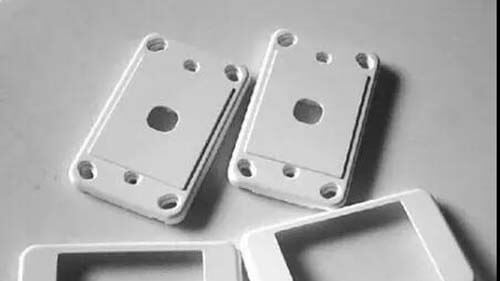What do I need to pay attention to in heat-resistant ABS injection molding? Reducing the internal stress of products is the key to heat-resistant ABS injection molding.
In this article, we share the main points of processing for heat-resistant ABS injection molding from 5 aspects: mold design, material drying, molding temperature, holding pressure and time, and injection mold temperature.

The heat resistance of ordinary ABS is not good enough. Now, a series of heat-resistant ABS resins have been developed by adding heat-resistant agents such as ɑ-methyl styrene copolymer and N-phenyl maleimide copolymer, with heat deflection temperature (HDT) of 90-120°C.
Since the molecular structure of heat-resistant ABS contains highly rigid benzene rings and N-phenyl groups, which improve heat resistance while increasing the spatial dislocation effect of molecular chains.
The relaxation rate of molecular chains decreases, making it easy for products to have large internal stresses, leading to defects such as stress cracking, stress whitening, and product brittleness.
Therefore, reducing the internal stress of the product is the key to heat-resistant ABS injection molding.
Heat-resistant ABS injection molding should pay attention to product mold design
The product’s wall thickness requires uniformity, and the wall thickness difference of ABS products should be controlled within 25% to prevent excessive wall thickness difference from causing local stress concentration.
The root of the weaker column needs to increase the R angle or additional reinforcement to prevent the column from fracturing.
In Snap design, the root of the snap needs to be chamfered R angle; the size of the R angle depends on the product’s wall thickness. R angle and wall thickness ratio should be above 0.3; with this ratio increases, the internal stress gradually decreases, but also consider the problem of product surface shrinkage.
The design of the cooling water channel of the mold should ensure the uniformity of cooling to avoid the internal stress caused by uneven cooling and shrinkage.
Heat-resistant ABS injection molding should pay attention to material drying
Usually, heat-resistant ABS resin absorbs moisture in the air during storage and transportation, and the water absorption rate varies with air humidity, Generally. Between 0.2 and 0.4%.
The material must be dried sufficiently to reduce the water content of the material to below 0.05%, preferably below 0.02%. Otherwise, surface malpractice, such as water splashes and silver filaments, may occur.
The drying temperature of heat-resistant ABS resin is higher than that of ordinary ABS, usually 80-95°C, and the drying time is 3-4 hours.
Heat-resistant ABS injection molding should pay attention to the molding temperature
The molding temperature is a parameter that requires special attention when processing heat-resistant ABS. It is set to ensure that the heat-resistant ABS is fully plasticized and should be set at the upper middle of the recommended molding temperature range.
Heat-resistant ABS injection molding should pay attention to holding pressure and time
For heat-resistant ABS injection molding holding, pressure and time settings are reasonable and directly impact the amount of internal stress in part.
The increase in holding pressure will cause the molecular gap to become smaller, the range of chain segment activity to decrease, the volume of the melt to shrink, the density to increase, and the force between molecules to increase, which can improve the shrinkage and internal quality of the product.
But it will lead to the internal stress becoming larger, so try to use a lower holding pressure to ensure the appearance of the product quality.
The pressure-holding time is set according to the time until the gate finishes its curing with cooling, and the screw advances again and no longer exerts pressure on the molded product.
If the holding time is too long, the material will be overfilled, the molecular gap will become smaller, and the internal stress will become bigger;
If the holding time is too short, the product will easily produce shrinkage, and the size will be unstable. The holding time should be set at the shortest time when the product’s weight no longer changes.
Heat-resistant ABS injection molding should pay attention to the mold temperature
When doing heat-resistant ABS injection molding, use a mold temperature machine to control the mold temperature; the recommended mold temperature is 60-80°C.
Higher mold temperatures produce good flow, higher fusion line strength, and less internal product stress, but the molding cycle time will be appropriately extended.
Suppose the mold temperature is lower than recommended. In that case, it will lead to high internal stress in the product, which will reduce the product’s performance and may result in undesirable phenomena such as brittle cracking of the product, cracking of the screw hole, or cracking of the spray paint.
Besides the 5 Heat-resistant ABS Injection Molding Attentions article, you may also be interested in the below.
6 Common Plastic Injection Molding Process Techniques
What is Multi-material Injection Molding?
How to Increase the Brightness of ABS Plastic Products?
Hot Runner Injection Molding Defects and Troubleshooting
11 Analyses of Injection Molding Process Parameters
17 Injection Molding Problems And Solutions
